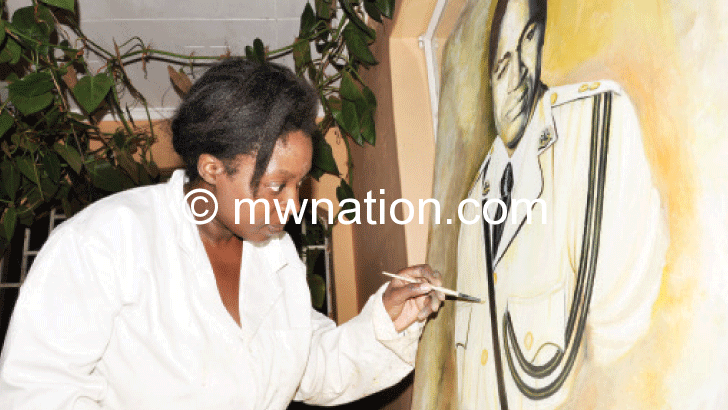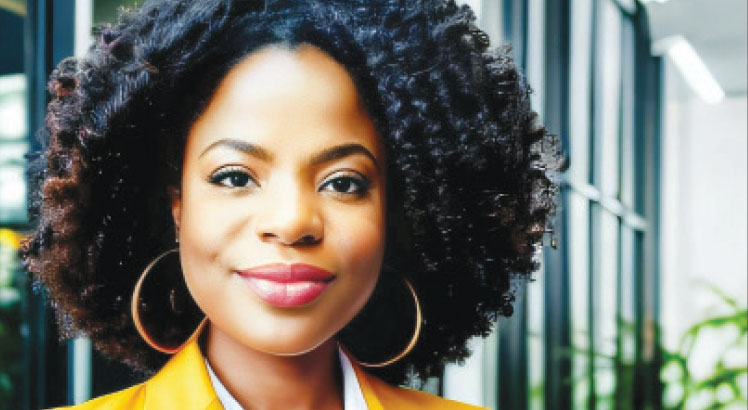EVA CHIKABADWA, PASSIONATE ABOUT ARTS
Many people rarely follow their passion and will do anything to make money and put food on their table. Eva Chikabadwa is a rare being who abandoned her initial career to learn arts. Now, she is a celebrated artist locally and internationally whose work is being exported. CHIKONDI KASAMBARA sought her to learn more from one of the few women artists.
Give us your brief background
I am 35 years old and was born in a family of six where I am the third born. My father was an agricultural extension worker who passed away in 2011 while my mother is a teacher. Because of the nature of my father’s job, we moved from one district to another. As I child, I enjoyed moving and always looked forward to the next move. I went to Senga Bay Primary School in Salima, Bwiba Full Primary School in Karonga, Chitedze Primary School and Saint Tereza Primary School in Liwonde among others. For my secondary education, I went to Salima Secondary School and Likuni Girls Secondary Schools. I am not married, but I have a fiancée, Clement Dulla and I have two children, four year-old Yewo, a girl and Peter who is a year old.
When did you realise your love for art?
I loved drawing as a child from my primary school years. As a toddler, I used to spoil the walls of our house with some charcoal drawings and my mother made me clean them often. At primary school, many teachers entrusted me with the responsibility of drawing on the board for my fellow students. I remember when I was in Standard Six, I was famous for drawing a bride at the back pages of either my notebooks or my friends’ and often got punished for it. At secondary school, I was voted president of the art club which unfortunately was banished. When I was selected to go to university, I wanted to major in fine art, but I was discouraged by my relatives, saying art is not appreciated in Malawi and, therefore, would not make a decent living out of it. I ended up doing the social sciences majoring in sociology. After school, I started working at the Geological Survey department doing a stone sculpture pilot project with 30 youths from Zomba and it was from this point that I realised my greater passion for art. At the Geological Survey, I was about to be fully employed so I could continue with my project, but I did not have relevant qualifications for the job and intended profession and was left out. I felt haunted that I did not study something I loved and I decided to go back to school for another four years to do art. I started teaching fine art at Chancellor College in 2011 till date.
What does your work involve?
My work mainly involves designing. I can easily do any kind of design as long as it is about the outlook only. I believe that art is anything to do with designing the outlook, be it fashion, makeup artistry, furniture, culinary art or food art. Art also involves interpretation and transformation of stories, ideas and imaginations into visual form. You would agree with me that many of us have never seen an angel or Jesus, but an artist somewhere suggested these things to us.

How do you feel to be among few lady sculptors and visual artists?
For the mean time, while we are still a few, I feel proud even though I know many women can easily do it. I remember during a Southern African Development Community (Sadc) Women’s Trade Fair back in 2002, I came across two women in wood sculpture, but I haven’t been able to trace them till now.
Why do women shun visual arts?
I do not think women shun it; it’s just that men have been dominating the trade, taking it as a source of income. Since art is not taught right from primary school, it is difficult for women to nurture and perfect their artistic skills because as it is, it is being passed on from father to son.
How far has your work gone?
I export my work to some private individuals and these are usually people who have travelled to Malawi from other countries. I, however, receive some orders through an international website known as Fine Art America, especially to do with portraiture, but so far, I haven’t been able to satisfy these customers because once they know I am miles away from them, they easily give up.
Is there a particular painting you are proud of that outshines the rest?
Yes! A recent one about M’bona. It is a painting that tries to imagine the death of M’bona in an extraordinary way. In this painting, M’bona is featured lying down, head cut off with the leading killer holding his head up declaring victory. From the head and the body flows a river of blood that turns into a real river. Downstream this river are people wondering where the river came from with some surprises that come with a river such as fish and crocodiles. Deep in the forest where M’bona was killed are angry ancestral spirits mourning for his death as a rainmaker.
What motivated you to do traditional storytelling through arts?
It started with the German Malawi Art Symposium organised by Chris Heide back in April last year. By then, I did Kachitsa and Kamdothi and this project really inspired me. I felt that Malawi was left behind when it came to storytelling through arts and saw a greater need for us to document our myths and legends through art. I felt ashamed when Agness Mizere, through her blog, used artistic illustrations from other countries to explain Malawian mythology. That’s when I felt it was my responsibility to do it for my country. This is not the only painting concerning M’bona that I am going to do. In the next two years, I plan to do more and I will stage an exhibition.
What are some of the challenges you face in your artistry work?
Art needs a lot of patience, one work can take as long as two months depending on the detail you want to achieve. M’bona art for example took me two solid months though I am not yet done with it because polishing it will take me another month. Interpretative art also involves a lot of thinking. It is not as easy as a portrait. To design a unique style is also a challenge. People always expect to see new creations.
How do you balance work and family?
Let me give credit to my nanny and house keeper who helps me take care of my children at home because I cannot manage on my own.
What is your advice to those that opt for a rewarding career against one that gives them satisfaction?
The younger generation should seek their heart to find what they love as a career before committing themselves to any profession because people who work to earn a living are usually frustrated with their jobs and don’t work efficiently. Our country can develop only if people work with passion. I love what I do both as a hobby and a career.
Whose artistic works do you admire?
On the international scene I admire Esther Mahlangu from South Africa, Proffesor Jane Alexander from University of Capetown who is also supervising my M’bona project and Wangechi Mutu from USA. Locally, the works of Ellis Singano, Peter Ndiyani, Elson Kambalu and George Mkumbula inspire me. n




